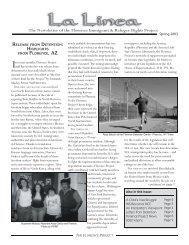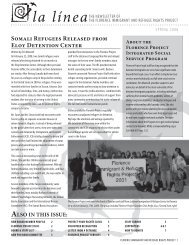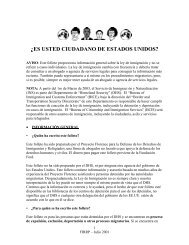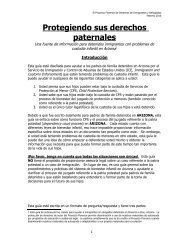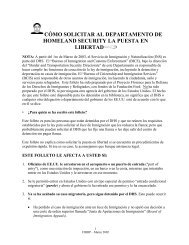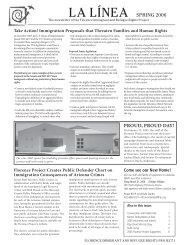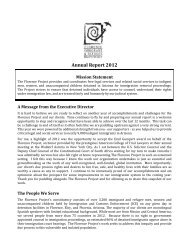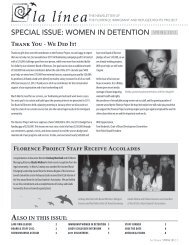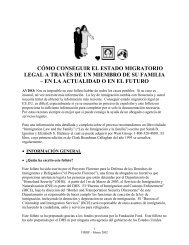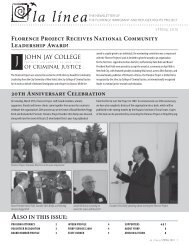quick reference chart and annotations for determining immigration ...
quick reference chart and annotations for determining immigration ...
quick reference chart and annotations for determining immigration ...
You also want an ePaper? Increase the reach of your titles
YUMPU automatically turns print PDFs into web optimized ePapers that Google loves.
Immigrant Legal Resource Center, Florence Immigrant <strong>and</strong> Refugee Rights Project,<br />
Maricopa County Public Defender August 2012<br />
entry “on” the structure or include both the “in or on” language in the plea; <strong>and</strong> 4) plead to entry of a<br />
“fenced commercial yard” or “fenced commercial or residential yard.”<br />
A2. Auto burglary in general is not AF burglary because it does not involve wrongful entry of a<br />
structure. Ye v INS, 214 F.3d 1128 (9th Cir. 2000). There<strong>for</strong>e this section is not an aggravated felony as<br />
burglary. If the entry was of a locked vehicle with an underlying intent to commit theft, however, it may<br />
be removable as an aggravated felony <strong>for</strong> attempted theft with a sentence of 365 days or more. Ngaeth v.<br />
Mukasey, 545 F.3d 796, 802 (9th Cir. 2008). Counsel should avoid <strong>reference</strong>s in the plea to a locked<br />
vehicle <strong>and</strong> an intent to commit theft.<br />
Explanation; AF as Attempted Theft. Conviction of an attempt to commit an offense involving<br />
theft is an aggravated felony if a sentence of one year or more is imposed. The Ninth Circuit has held that<br />
a conviction <strong>for</strong> entering a locked vehicle with the intent to commit theft constitutes an aggravated felony<br />
if the sentence is 365 days or more. Ngaeth v. Mukasey, 545 F.3d 796, 802 (9th Cir. 2008). There<strong>for</strong>e, a<br />
plea to A2 in which the underlying intent involved theft would likely be an aggravated felony. Defense<br />
counsel should keep the record of conviction clear of what the intended crime was, i.e., plead to “theft or<br />
any felony” in the disjunctive, or to “any felony.” Immigration counsel can point to Ninth Circuit<br />
decisions holding that Arizona theft is broader than the generic definition of theft, <strong>and</strong> even if the record<br />
of conviction reveals that defendant intended to commit “any theft” it is unclear whether it was theft of<br />
services or theft of property, or whether any intent to deprive the owner was involved.<br />
AF as a Crime of Violence:<br />
A1. Felony burglary of a residence is a crime of violence because of the inherent risk that the<br />
burglar will encounter one of its lawful occupants <strong>and</strong> <strong>for</strong>ce will be used. United States v. Becker, 919<br />
F.2d 568 (9th Cir. 1990); Lopez–Cardona v. Holder, 662 F.3d 1110 (9th Cir. 2011); United States v.<br />
Ramos-Medina, 682 F.3d 852, 855 (9th Cir. 2012). Burglary of even a residential yard similarly may be<br />
held a crime of violence. James v. United States, 127 S.Ct. 1586, 1589 (2007). However, <strong>immigration</strong><br />
counsel have arguments that burglary of a fenced residential yard under Arizona law is not categorically a<br />
crime of violence since the definition of “residential structure” under ARS § 13-1501(11) includes<br />
structures that are not occupied, i.e. that do not have tenants or homeowners residing there. See U.S. v.<br />
Martinez-Martinez, 468 F.3d 604 (9th Cir. 2006) (holding that discharging a firearm at a residential<br />
structure under ARS § 13-1211 is not categorically a crime of violence since the structure need not be<br />
occupied under the statute in order to be defined as “residential”). If burglary of an unoccupied residence<br />
is not a crime of violence, then the same should hold true <strong>for</strong> burglary of a fenced yard of an unoccupied<br />
residence. However, defense counsel can create additional safeguards by pleading to either burglary of a<br />
“nonresidential structure or a fenced commercial or residential yard” or “a fenced commercial yard.”<br />
A2. Auto burglary is not a crime of violence as long as the record of conviction does not establish<br />
that actual violence was used, e.g. does not establish that the car window was smashed, as opposed to<br />
found open. Ye v. INS, supra.<br />
Domestic Violence: Where felony burglary is a crime of violence <strong>and</strong> there is a DV type victim,<br />
it is possible that it will be held a domestic violence offense triggering deportation. Counsel should avoid<br />
a <strong>reference</strong> to § 13-3601<strong>and</strong> keep the record of conviction from identifying the domestic relationship.<br />
However, <strong>immigration</strong> counsel have a strong argument that only crimes against persons, not property,<br />
qualify as deportable domestic violence offenses.<br />
Burglary in the Second Degree, ARS §13-1507<br />
A. A person commits burglary in the second degree by entering or remaining unlawfully in or on a<br />
residential structure with the intent to commit any theft or any felony therein.<br />
Arizona Criminal Chart with Explanatory Endnote – August 2012<br />
47



